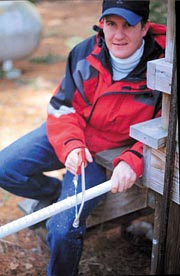
In many cases, the well construction regulations may dictate that the top of the screen be placed above the mean high water table to ensure capture of any possible lightweight (floating) compounds, i.e., motor fuels or lubricants. However, the natural fluctuation range of the water table may be greater than the length of the screen, making it nearly impossible to construct a well that would meet all of the necessary criteria.
Monitoring wells located near brackish or saltwater likely will change in water quality dramatically with depth due to the "fresh water lenses" that form from rainfall, which tend to "float" on top of the more dense saltwater. The water quality from a single sample in this setting well often will change with rainfall and even the tides.
Probably the most important factor in determining the depth of a monitoring well is the relative ground water level at the time of installation. Many wells have been installed during unusually wet times and the short screen placed a little more than halfway below the water at the time. Later when the water levels drop to normal or below normal conditions, the well does not have any water to measure or sample. This causes you to be embarrassed, and your client and regulatory people are unhappy. However, the well driller is smiling because he gets to install more and deeper wells.


Report Abusive Comment